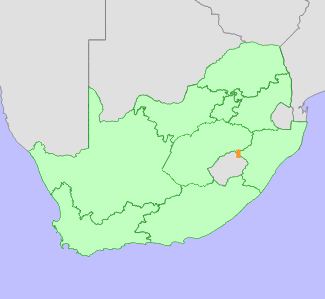|
Scientific Name | Protea nubigena Rourke |
Higher Classification | Dicotyledons |
Family | PROTEACEAE |
Common Names | Cloud Sugarbush (e) |
National Status |
Status and Criteria | Critically Endangered B1ab(v); C2a(ii) |
Assessment Date | 2020/03/31 |
Assessor(s) | A.G. Rebelo, H. Mtshali & L. von Staden |
Justification | Protea nubigena has a very narrow distribution, with an extent of occurrence (EOO) and area of occupancy of 12 km². A single population, consisting of fewer than 50 mature individuals at one known location, continues to decline due to poor recruitment possibly as a result of inappropriate fire management. It therefore qualifies for listing as Critically Endangered under criteria B and C. |
Distribution |
Endemism | South African endemic |
Provincial distribution | KwaZulu-Natal |
Range | This species is endemic to the uKhahlamba Drakensberg Park in KwaZulu-Natal, South Africa. |
Habitat and Ecology |
Major system | Terrestrial |
Major habitats | uKhahlamba Basalt Grassland, Drakensberg-Amathole Afromontane Fynbos |
Description | It occurs on well shaded cliff slopes with well-drained, humus-rich soil, at 2200-2450 m. It is a long-lived species, and survives fires by resprouting from underground boles or rootstocks. Wind-dispersed seeds are not stored on the plant, and are released immediately after ripening. It is pollinated by birds. |
Threats |
| The population is very small in size, and there is no evidence of recruitment since 1964 (Scott-Shaw, 1999). This species is susceptible to extinction due to inbreeding, thus genetic decline is inferred. Field surveys noted very frequent fires in the past in the whole of the Drakensberg area (Pajor, 1991). Lack of fire may also be a threat to this resprouter. |
Population |
The population is suspected to be declining as no recruitment has been observed since 1964. Different estimates exist of the population size as counting plants is challenged by the fact that this species has underground rootstocks and it is difficult to ascertain which above ground stems belong to separate individuals. Estimates include 50 plants (Rourke, 1980), 40 (Scott-Shaw, 1995, 1999), and Pajor (1995) states that in 1995 the population was only 60% of the 1991 size, when it occurred as 3 or 4 clumps, each 30-50 m apart, and each comprising 10-50 plants, with each plant consisting of about 20 basal stems from a rootstock (Pajor, 1991). Repeated searches have yielded no additional subpopulations. The latest observation of this subpopulation was in 2015 by a member of the Custodians of Rare and Endangered Wildflowers (CREW) Programme (a citizen scientist programme that monitors rare and threatened plants), however the number of plants seen was not noted. It is estimated that there are fewer than 50 mature individuals remaining, and that the population is declining slowly.
|
Population trend | Decreasing |
Conservation |
| The only known population occurs in the Ukhahlamba Drakensberg Park. This species has been grown in cultivation at Kirstenbosch Botanic Gardens from seeds indicating that the population is able to produce viable seed. This suggests that the lack of recruitment in the wild population must be due to establishment conditions for seedlings. |
Assessment History |
Taxon assessed |
Status and Criteria |
Citation/Red List version | | Protea nubigena Rourke | CR B1ab(v)+2ab(v); D | Raimondo et al. (2009) | | Protea nubigena Rourke | CR | Scott-Shaw (1999) | | Protea nubigena Rourke | Endangered | Hilton-Taylor (1996) | |
Bibliography |
Hilton-Taylor, C. 1996. Red data list of southern African plants. Strelitzia 4. South African National Botanical Institute, Pretoria.
Pajor, I. 1991. Protea nubigena Cloud Protea in the Drakensberg. Protea Atlas Newsletter 12:7.
Pooley, E. 2003. Mountain flowers: a field guide to the flora of the Drakensberg and Lesotho. Natal Flora Publications Trust, Durban.
Raimondo, D., von Staden, L., Foden, W., Victor, J.E., Helme, N.A., Turner, R.C., Kamundi, D.A. and Manyama, P.A. 2009. Red List of South African Plants. Strelitzia 25. South African National Biodiversity Institute, Pretoria.
Rebelo, T. 2001. Sasol Proteas: A field guide to the proteas of southern Africa. (2nd ed.). Fernwood Press, Vlaeberg, Cape Town.
Scott-Shaw, C.R. 1999. Rare and threatened plants of KwaZulu-Natal and neighbouring regions. KwaZulu-Natal Nature Conservation Service, Pietermaritzburg.
|
Citation |
| Rebelo, A.G., Mtshali, H. & von Staden, L. 2020. Protea nubigena Rourke. National Assessment: Red List of South African Plants version 2024.1. Accessed on 2025/10/17 |
 Comment on this assessment
Comment on this assessment

